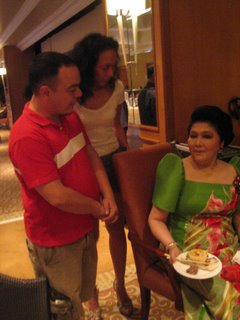Republic of the Philippines
HOUSE OF REPRESENTATIVES
Quezon City, Metro Manila
FOURTEENTH CONGRESS
FIRST REGULAR SESSION
HOUSE BILL NO. __5043___
Introduced by HONORABLES EDCEL C. LAGMAN, JANETTE L. GARIN, NARCISO D. SANTIAGO III, MARK LLANDRO MENDOZA, ELEANDRO JESUS F. MADRONA, ANA THERESIA HONTIVEROS-BARAQUEL
AN ACT
PROVIDING FOR A NATIONAL POLICY ON REPRODUCTIVE HEALTH, RESPONSIBLE PARENTHOOD AND POPULATION DEVELOPMENT, AND FOR OTHER PURPOSES
Be it enacted by the Senate and the House of Representatives of the Philippines in Congress assembled:
SECTION 1. Short Title. – This Act shall be known as the “Reproductive Health and Population Development Act of 2007”.
SEC. 2. Declaration of Policy. – The State upholds and promotes responsible parenthood, informed choice, birth spacing and respect for life in conformity with internationally recognized human rights standards.
The State shall uphold the right of the people, particularly women and their organizations, to effective and reasonable participation in the formulation and implementation of the declared policy.
This policy is anchored on the rationale that sustainable human development is better assured with a manageable population of healthy, educated and productive citizens.
The State likewise guarantees universal access to medically-safe, legal, affordable and quality reproductive health care services, methods, devices, supplies and relevant information thereon even as it prioritizes the needs of women and children, among other underprivileged sectors.
SEC. 3. Guiding Principles. – This Act declares the following as basic guiding principles:
In the promotion of reproductive health, there should be no bias for either modern or natural methods of family planning;
Reproductive health and population development goes beyond a demographic target because it is principally about health and rights;
Gender equality and women empowerment are central elements of reproductive health and population development;
Since manpower is the principal asset of every country, effective reproductive health care services must be given primacy to ensure the birth and care of healthy children and to promote responsible parenting;
The limited resources of the country cannot be suffered to be spread so thinly to service a burgeoning multitude that makes the allocations grossly inadequate and effectively meaningless;
Freedom of informed choice, which is central to the exercise of any right, must be fully guaranteed by the State like the right itself;
While the number and spacing of children are left to the sound judgment of parents and couples based on their personal conviction and religious beliefs, such concerned parents and couples, including unmarried individuals, should be afforded free and full access to relevant, adequate and correct information on reproductive health and human sexuality and should be guided by qualified State workers and professional private practitioners;
Reproductive health, including the promotion of breastfeeding, must be the joint concern of the National Government and Local Government Units;
Protection and promotion of gender equality, woman empowerment and human rights, including reproductive health rights, are imperative;
Development is a multi-faceted process that calls for the coordination and integration of policies, plans, programs and projects that seek to uplift the quality of life of the people, more particularly the poor, the needy and the marginalized;
Active participation by and thorough consultation with concerned non-government organizations (NGOs), people’s organizations (POs) and communities are imperative to ensure that basic policies, plans, programs and projects address the priority needs of stakeholders;
Respect for, protection and fulfillment of reproductive health rights seek to promote not only the rights and welfare of adult individuals and couples but those of adolescents’ and children’s as well; and
While nothing in this Act changes the law on abortion, as abortion remains a crime and is punishable, the government shall ensure that women seeking care for post-abortion complications shall be treated and counseled in a humane, non-judgmental and compassionate manner.
SEC. 4. Definition of Terms. – For purposes of this Act, the following terms shall be defined as follows:
Responsible Parenthood - the will, ability and commitment of parents to respond to the needs and aspirations of the family and children more particularly through family planning.
Family Planning - a program which enables couples and individuals to decide freely and responsibly the number and spacing of their children and to have the information and means to carry out their decisions, and to have informed choice and access to a full range of safe, legal and effective family planning methods, techniques and devices.
Reproductive Health - the state of physical, mental and social well-being and not merely the absence of disease or infirmity, in all matters relating to the reproductive system and to its functions and processes. This implies that people are able to have a satisfying and safe sex life, that they have the capability to reproduce and the freedom to decide if, when and how often to do so, provided that these are not against the law. This further implies that women and men are afforded equal status in matters related to sexual relations and reproduction.
Reproductive Health Rights - the rights of individuals and couples to decide freely and responsibly the number, spacing and timing of their children; to make other decisions concerning reproduction free of discrimination, coercion and violence; to have the information and means to carry out their decisions; and to attain the highest standard of sexual and reproductive health.
Gender Equality - the absence of discrimination on the basis of a person’s sex, in opportunities, allocation of resources and benefits, and access to services.
Gender Equity - fairness and justice in the distribution of benefits and responsibilities between women and men, and often requires women-specific projects and programs to eliminate existing inequalities, inequities, policies and practices unfavorable to women.
Reproductive Health Care - availability and access to a full range of methods, techniques, supplies and services that contribute to reproductive and sexual health and well-being by preventing and solving reproductive health-related problems in order to achieve enhancement of life and personal relations. The elements of reproductive health care include:
Maternal, infant and child health and nutrition;
Promotion of breastfeeding;
Family planning information and services;
Prevention of abortion and management of post-abortion complications;
Adolescent and youth health;
Prevention and management of reproductive tract infections (RTIs), HIV/AIDS and other sexually transmittable infections (STIs);
Elimination of violence against women;
Education and counseling on sexuality and sexual and reproductive health;
Treatment of breast and reproductive tract cancers and other gynecological conditions;
Male involvement and participation in reproductive health;
Prevention and treatment of infertility and sexual dysfunction; and
Reproductive health education for the youth.
Reproductive Health Education - is the process of acquiring complete, accurate and relevant information on all matters relating to the reproductive system, its functions and processes and human sexuality; and forming attitudes and beliefs about sex, sexual identity, interpersonal relationships, affection, intimacy and gender roles. It also includes developing the necessary skills to be able to distinguish between facts and myths on sex and sexuality; and critically evaluate and discuss the moral, religious, social and cultural dimensions of related sensitive issues such as contraception and abortion.
Male involvement and participation - refers to the involvement, participation, commitment and joint responsibility of men with women in all areas of sexual and reproductive health, as well as reproductive health concerns specific to men.
Reproductive tract infection (RTI) - includes sexually transmitted infections, sexually transmitted diseases and other types of infections affecting the reproductive system.
Basic Emergency Obstetric Care - lifesaving services for maternal complication being provided by a health facility or professional, which must include the following six signal functions: administration of parenteral antibiotics; administration of parenteral oxytocic drugs; administration of parenteral anticonvulsants for pre-eclampsia and eclampsia; manual removal of placenta; and assisted vaginal delivery.
Comprehensive Emergency Obstetric Care - basic emergency obstetric care plus two other signal functions: performance of caesarean section and blood transfusion.
Maternal Death Review - refers to a qualitative and in-depth study of the causes of maternal death with the primary purpose of preventing future deaths through changes or additions to programs, plans and policies.
Skilled Attendant - an accredited health professional such as a licensed midwife, doctor or nurse who has adequate proficiency and the skills to manage normal (uncomplicated) pregnancies, childbirth and the immediate postnatal period, and in the identification, management and referral of complication in women and newborns.
Skilled Attendance - childbirth managed by a skilled attendant under the enabling conditions of a functional emergency obstetric care and referral system.
Development - is a multi-dimensional process involving major changes in social structures, popular attitudes, and national institutions as well as the acceleration of economic growth, the reduction of inequality and the eradication of widespread poverty.
Sustainable Human Development - the totality of the process of expanding human choices by enabling people to enjoy long, healthy and productive lives, affording them access to resources needed for a decent standard of living and assuring continuity and acceleration of development by achieving a balance between and among a manageable population, adequate resources and a healthy environment.
Population Development - a program that aims to: (1) help couples and parents achieve their desired family size; (2) improve reproductive health of individuals by addressing reproductive health problems; (3) contribute to decreased maternal and infant mortality rates and early child mortality; (4) reduce incidence of teenage pregnancy; and (5) enable government to achieve a balanced population distribution.
SEC. 5. The Commission on Population (POPCOM). – Pursuant to the herein declared policy, the Commission on Population (POPCOM) shall serve as the central planning, coordinating, implementing and monitoring body for the comprehensive and integrated policy on reproductive health and population development. In the implementation of this policy, POPCOM, which shall be an attached agency of the Department of Health (DOH) shall have the following functions:
To create an enabling environment for women and couples to make an informed choice regarding the family planning method that is best suited to their needs and personal convictions;
To integrate on a continuing basis the interrelated reproductive health and population development agenda into a national policy, taking into account regional and local concerns;
To provide the mechanism to ensure active and full participation of the private sector and the citizenry through their organizations in the planning and implementation of reproductive health care and population development programs and projects;
To ensure people’s access to medically safe, legal, quality and affordable reproductive health goods and services;
To facilitate the involvement and participation of non-government organizations and the private sector in reproductive health care service delivery and in the production, distribution and delivery of quality reproductive health and family planning supplies and commodities to make them accessible and affordable to ordinary citizens;
To fully implement the Reproductive Health Care Program with the following components:
Reproductive and sexual health education including but not limited to counseling on the full range of legal and medically-safe family planning methods including surgical methods;
Maternal, peri-natal and post-natal education, care and services;
Promotion of breastfeeding;
Promotion of male involvement, participation and responsibility in reproductive health as well as other reproductive health concerns of men;
Prevention of abortion and management of post-abortion complications; and
Provision of information and services addressing the reproductive health needs of the poor, senior citizens, women in prostitution, differently-abled persons, and women and children in war crisis situations.
To ensure that reproductive health services are delivered with a full range of supplies, facilities and equipment and that service providers are adequately trained for reproductive health care;
To endeavor to furnish local Family Planning Offices with appropriate information and resources to keep the latter updated on current studies and research relating to family planning, responsible parenthood, breastfeeding and infant nutrition;
To direct all public hospitals to make available to indigent mothers who deliver their children in these government hospitals, upon the mother’s request, the procedure of ligation without cost to her;
To recommend the enactment of legislation and adoption of executive measures that will strengthen and enhance the national policy on reproductive health and population development;
To ensure a massive and sustained information drive on responsible parenthood and on all methods and techniques to prevent unwanted, unplanned and mistimed pregnancies, it shall release information bulletins on the same for nationwide circulation to all government departments, agencies and instrumentalities, non-government organizations and the private sector, schools, public and private libraries, tri-media outlets, workplaces, hospitals and concerned health institutions;
To strengthen the capacities of health regulatory agencies to ensure safe, high-quality, accessible, and affordable reproductive health services and commodities with the concurrent strengthening and enforcement of regulatory mandates and mechanisms;
To take active steps to expand the coverage of the National Health Insurance Program (NHIP), especially among poor and marginalized women, to include the full range of reproductive health services and supplies as health insurance benefits; and
To perform such other functions necessary to attain the purposes of this Act.
The membership of the Board of Commissioners of POPCOM shall consist of the heads of the following:
National Economic Development Authority (NEDA)
Department of Health (DOH)
Department of Social Welfare and Development (DSWD)
Department of Labor and Employment (DOLE)
Department of Agriculture (DA)
Department of the Interior and Local Government (DILG)
Department of Education (DepEd)
Department of Environment and Natural Resources (DENR)
Commission on Higher Education (CHED)
University of the Philippines Population Institute (UPPI)
Union of Local Authorities of the Philippines (ULAP)
National Anti-Poverty Commission (NAPC)
National Commission on the Role of Filipino Women (NCRFW)
National Youth Commission (NYC)
In addition to the aforementioned members, there shall be three private sector representatives to the Board of Commissioners of POPCOM who shall come from NGOs. There shall be one (1) representative each from women, youth and health sectors who have a proven track record of involvement in the promotion of reproductive health. These representatives shall be nominated in a process determined by the above-mentioned sectors, and to be appointed by the President for a term of three (3) years.
SEC. 6. Midwives for Skilled Attendance – Every city and municipality shall endeavor to employ adequate number of midwives or other skilled attendants to achieve a minimum ratio of one for every 150 deliveries per year, to be based on the average annual number of actual deliveries or live births for the past two years.
SEC. 7. Emergency Obstetric Care – Each province and city shall endeavor to ensure the establishment and operation of hospitals with adequate and qualified personnel that provide emergency obstetric care. For every 500,000 population, there shall be at least one (1) hospital for comprehensive emergency obstetric care and four (4) hospitals for basic emergency obstetric care.
SEC. 8. Maternal Death Review – All Local Government Units (LGUs), national and local government hospitals, and other public health units shall conduct maternal death review in accordance with the guidelines to be issued by the DOH in consultation with the POPCOM.
SEC. 9. Hospital-Based Family Planning –Tubal ligation, vasectomy and other family planning methods requiring hospital services shall be available in all national and local government hospitals, except in specialty hospitals which may render such services on an optional basis. Such services shall be covered by PhilHealth benefits and government funding for financial assistance to indigent patients.
The cost of tubal ligation, vasectomy and intrauterine device insertion for indigent clients shall be fully subsidized by PhilHealth.
SEC. 10. Contraceptives as Essential Medicines. – Hormonal contraceptives, intrauterine devices, injectables and other allied reproductive health products and supplies shall be considered under the category of essential medicines and supplies which shall form part of the National Drug Formulary and the same shall be included in the regular purchase of essential medicines and supplies of all national and local hospitals and other government health units.
SEC. 11. Mobile Health Care Service. – Each Congressional District shall be provided with a van to be known as the Mobile Health Care Service (MHCS) to deliver health care goods and services to its constituents, more particularly to the poor and needy, as well as disseminate knowledge and information on reproductive health: Provided, That reproductive health education shall be conducted by competent and adequately trained persons preferably reproductive health care providers: Provided, further, That the full range of family planning methods, both natural and modern, shall be promoted.
The acquisition, operation and maintenance of the MHCS shall be funded from the Priority Development Assistance Fund (PDAF) of each Congressional District.
The MHCS shall be adequately equipped with a wide range of reproductive health care materials and information dissemination devices and equipment, the latter including but not limited to, a television set for audio-visual presentation.
SEC. 12. Mandatory Age-Appropriate Reproductive Health Education. - Recognizing the importance of reproductive health rights in empowering the youth and developing them into responsible adults, Reproductive Health Education in an age-appropriate manner shall be taught by adequately trained teachers starting from Grade 5 up to Fourth Year High School. In order to assure the prior training of teachers on reproductive health, the implementation of Reproductive Health Education shall commence at the start of the school year one year following the effectivity of this Act. The POPCOM, in coordination with the Department of Education, shall formulate the Reproductive Health Education curriculum, which shall be common to both public and private schools and shall include related population and development concepts in addition to the following subjects and standards:
Reproductive health and sexual rights;
Reproductive health care and services;
Attitudes, beliefs and values on sexual development, sexual behavior and sexual health;
Proscription and hazards of abortion and management of post-abortion complications;
Responsible parenthood;
Use and application of natural and modern family planning methods to promote reproductive health, achieve desired family size and prevent unwanted, unplanned and mistimed pregnancies;
Abstinence before marriage;
Prevention and treatment of HIV/AIDS and other STIs/STDs, prostate cancer, breast cancer, cervical cancer and other gynecological disorders;
Responsible sexuality; and
Maternal, peri-natal and post-natal education, care and services
In support of the natural and primary right of parents in the rearing of the youth, the POPCOM shall provide concerned parents with adequate and relevant scientific materials on the age-appropriate topics and manner of teaching reproductive health education to their children.
In the elementary level, reproductive health education shall focus, among others, on values formation.
Non-formal education programs shall likewise include the abovementioned Reproductive Health Education.
SEC. 13. Additional Duty of Family Planning Office. - Each local Family Planning Office shall furnish for free instructions and information on family planning, responsible parenthood, breastfeeding and infant nutrition family to all applicants for marriage license.
SEC. 14. Certificate of Compliance. – No marriage license shall be issued by the Local Civil Registrar unless the applicants present a Certificate of Compliance issued for free by the local Family Planning Office certifying that they had duly received adequate instructions and information on family planning, responsible parenthood, breastfeeding and infant nutrition.
SEC. 15. Capability Building of Community-Based Volunteer Workers. – Community-based volunteer workers, like but not limited to, Barangay Health Workers, shall undergo additional and updated training on the delivery of reproductive health care services and shall receive not less than 10% increase in honoraria upon successful completion of training. The increase in honoraria shall be funded from the Gender and Development (GAD) budget of the National Economic and Development Authority (NEDA), Department of Health (DOH) and the Department of the Interior and Local Government (DILG).
SEC. 16. Ideal Family Size. – The State shall assist couples, parents and individuals to achieve their desired family size within the context of responsible parenthood for sustainable development and encourage them to have two children as the ideal family size. Attaining the ideal family size is neither mandatory nor compulsory. No punitive action shall be imposed on parents having more than two children.
SEC. 17. Employers’ Responsibilities. – Employers shall respect the reproductive health rights of all their workers. Women shall not be discriminated against in the matter of hiring, regularization of employment status or selection for retrenchment.
All Collective Bargaining Agreements (CBAs) shall provide for the free delivery by the employer of reasonable quantity of reproductive health care services, supplies and devices to all workers, more particularly women workers. In establishments or enterprises where there are no CBAs or where the employees are unorganized, the employer shall have the same obligation.
SEC. 18. Support of Private and Non-government Health Care Service Providers. - Pursuant to Section 5(b) hereof, private reproductive health care service providers, including but not limited to gynecologists and obstetricians, are encouraged to join their colleagues in non-government organizations in rendering such services free of charge or at reduced professional fee rates to indigent and low income patients.
SEC. 19. Multi-Media Campaign. POPCOM shall initiate and sustain an intensified nationwide multi-media campaign to raise the level of public awareness on the urgent need to protect and promote reproductive health and rights.
SEC. 20. Reporting Requirements. - Before the end of April of each year, the DOH shall submit an annual report to the President of the Philippines, the President of the Senate and the Speaker of the House of Representatives on a definitive and comprehensive assessment of the implementation of this Act and shall make the necessary recommendations for executive and legislative action. The report shall be posted in the website of DOH and printed copies shall be made available to all stakeholders.
SEC. 21. Prohibited Acts. – The following acts are prohibited:
Any health care service provider, whether public or private, who shall:
Knowingly withhold information or impede the dissemination thereof, and/or intentionally provide incorrect information regarding programs and services on reproductive health including the right to informed choice and access to a full range of legal, medically-safe and effective family planning methods;
Refuse to perform voluntary ligation and vasectomy and other legal and medically-safe reproductive health care services on any person of legal age on the ground of lack of spousal consent or authorization.
Refuse to provide reproductive health care services to an abused minor, whose abused condition is certified by the proper official or personnel of the Department of Social Welfare and Development (DSWD) or to duly DSWD-certified abused pregnant minor on whose case no parental consent is necessary.
Fail to provide, either deliberately or through gross or inexcusable negligence, reproductive health care services as mandated under this Act, the Local Government Code of 1991, the Labor Code, and Presidential Decree 79, as amended; and
Refuse to extend reproductive health care services and information on account of the patient’s civil status, gender or sexual orientation, age, religion, personal circumstances, and nature of work: Provided, That all conscientious objections of health care service providers based on religious grounds shall be respected: Provided, further, That the conscientious objector shall immediately refer the person seeking such care and services to another health care service provider within the same facility or one which is conveniently accessible: Provided, finally, That the patient is not in an emergency or serious case as defined in RA 8344 penalizing the refusal of hospitals and medical clinics to administer appropriate initial medical treatment and support in emergency and serious cases.
Any public official who prohibits or restricts personally or through a subordinate the delivery of legal and medically-safe reproductive health care services, including family planning;
Any employer who shall fail to comply with his obligation under Section 17 of this Act or an employer who requires a female applicant or employee, as a condition for employment or continued employment, to involuntarily undergo sterilization, tubal ligation or any other form of contraceptive method;
Any person who shall falsify a certificate of compliance as required in Section 14 of this Act; and
Any person who maliciously engages in disinformation about the intent or provisions of this Act.
SEC. 22. Penalties. - The proper city or municipal court shall exercise jurisdiction over violations of this Act and the accused who is found guilty shall be sentenced to an imprisonment ranging from one (1) month to six (6) months or a fine ranging from Ten Thousand Pesos (P10,000.00) to Fifty Thousand Pesos (P50,000.00) or both such fine and imprisonment at the discretion of the court. If the offender is a juridical person, the penalty shall be imposed upon the president, treasurer, secretary or any responsible officer. An offender who is an alien shall, after service of sentence, be deported immediately without further proceedings by the Bureau of Immigration. An offender who is a public officer or employee shall suffer the accessory penalty of dismissal from the government service.
Violators of this Act shall be civilly liable to the offended party in such amount at the discretion of the proper court.
SEC. 23. Appropriations. – The amounts appropriated in the current annual General Appropriations Act for reproductive health and family planning under the DOH and POPCOM together with ten percent (10%) of the Gender and Development (GAD) budgets of all government departments, agencies, bureaus, offices and instrumentalities funded in the annual General Appropriations Act in accordance with Republic Act No. 7192 (Women in Development and Nation-building Act) and Executive Order No. 273 (Philippine Plan for Gender Responsive Development 1995-2025) shall be allocated and utilized for the implementation of this Act. Such additional sums as may be necessary for the effective implementation of this Act shall be included in the subsequent years’ General Appropriations Acts.
SEC. 24. Implementing Rules and Regulations. – Within sixty (60) days from the effectivity of this Act, the Department of Health, the National Economic and Development Authority (NEDA) and the Commission on Population shall jointly promulgate, after thorough consultation with concerned non-government organizations (NGOs) and known reproductive health advocates, the requisite implementing rules and regulations.
SEC. 25. Separability Clause. – If any part, section or provision of this Act is held invalid or unconstitutional, other provisions not affected thereby shall remain in full force and effect.
SEC. 26. Repealing Clause. – All other laws, decrees, orders, issuances, rules and regulations contrary to or inconsistent with the provisions of this Act are hereby repealed, amended or modified accordingly.
SEC. 27. Effectivity. – This Act shall take effect fifteen (15) days after its publication in at least two (2) newspapers of national circulation.
Approved,
 I got interviewed by the inimitably irreverent Benito Vergara. He is the thinking man's Mo' Twister of blog interviews. Nice chap. Nice questions. Not so nice answers.
I got interviewed by the inimitably irreverent Benito Vergara. He is the thinking man's Mo' Twister of blog interviews. Nice chap. Nice questions. Not so nice answers.













































